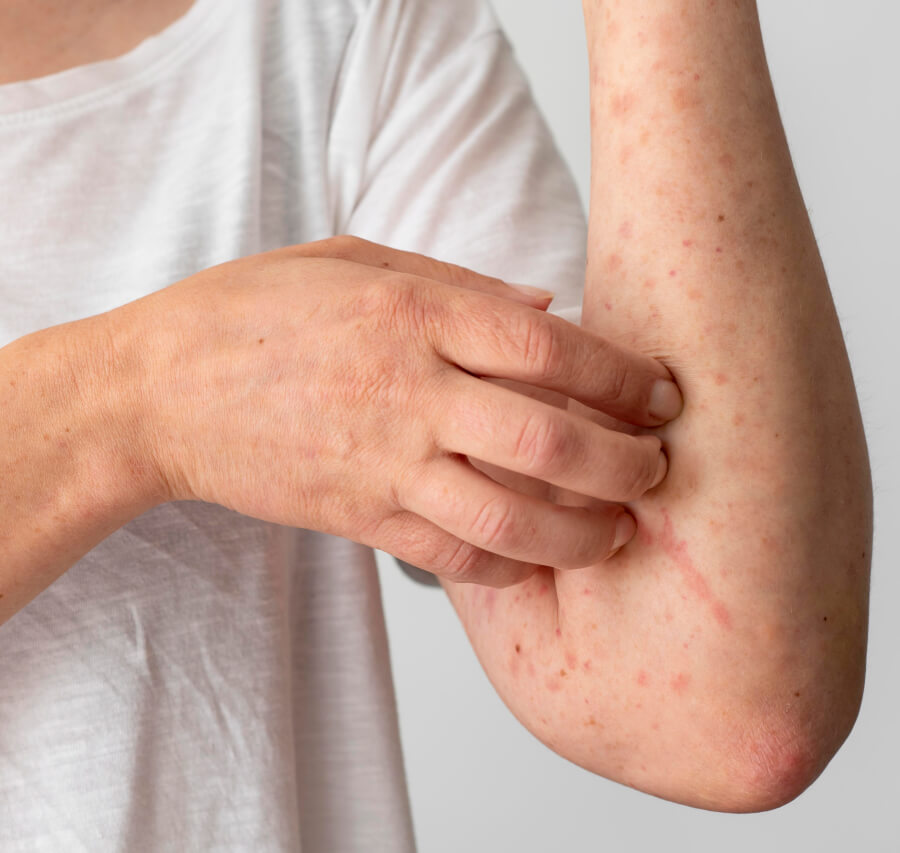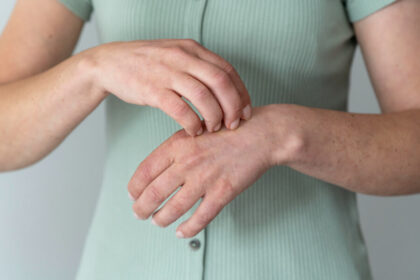Eczema, a multifaceted skin condition, dances across the canvas of human skin, leaving behind a symphony of symptoms—itching, redness, and discomfort.
It’s a condition that transcends age, ethnicity, and geography, affecting millions worldwide.
As we delve into the seven distinct types of it, let’s unravel the mysteries, debunk myths, and empower ourselves with knowledge.
Prevalence and Persistence
First it doesn’t discriminate. It affects people across the spectrum of life.
One in 10 individuals will encounter eczema during their lifetime1.
While it often begins in childhood, some adults continue to grapple with its nuances.
The Atopic Triad
Atopic dermatitis (AD), the most common form of eczema, is part of a trio—the atopic triad.
This triad includes AD, asthma, and hay fever.
Many eczema warriors bear this trifecta, navigating allergies, itchy skin, and respiratory challenges.
Skin Tones and Eczema
Eczema wears different hues on various skin tones.
Pale skin may blush crimson, while darker tones can appear ashen, purple, or even grey.
Brown and Black skin may harbor tiny bumps on the torso, arms, and legs, revealing eczema’s diverse palette.
The Itch Factor
It isn’t merely a skin condition; it’s an itch orchestra.
The majority of it’s warriors report uncontrollable itch that defies reason.
Scratching becomes a frenzied dance, leaving skin vulnerable and prone to infections.
Dermatologists and allergists wield their expertise, prescribing creams, ointments, and light therapy.
As we embark on this voyage through eczema’s labyrinth, remember that knowledge is our compass.
Together, we’ll explore each type, decode their symptoms, and unravel the threads that bind them.
So, tighten your shoelaces, for we’re about to step into the world of eczema—one symptom, one trigger, and one revelation at a time.
It’s common – 1 in 10 people will experience eczema at some point in their lives;
1. Atopic Dermatitis (AD)
Symptoms
- The rash often appears in the creases of elbows or knees.
- Skin in affected areas may become lighter, darker, or thicker.
- Small fluid-filled bumps may develop if scratched.
- Babies often experience the rash on their scalp and cheeks.
- Intense itching is a common feature.
Causes
- Genetic factors play a significant role.
- Dry skin and impaired skin barrier function contribute.
- Allergies and immune system dysfunction are associated.
Treatment
- Moisturize regularly to maintain skin hydration.
- Topical corticosteroids and immunomodulators help manage inflammation.
- Avoid triggers such as harsh soaps and allergens.
2. Dyshidrotic Eczema
Symptoms
- Characterized by small, itchy blisters on the palms, fingers, and soles.
- Blisters may burst, leading to peeling and cracking skin.
Causes
- Often triggered by stress, allergies, or exposure to irritants.
- Sweating and humid conditions can exacerbate symptoms.
Treatment
- Keep hands and feet dry.
- Use mild soaps and moisturizers.
- Topical steroids and antihistamines may be prescribed.
3. Contact Dermatitis
Symptoms
- Red, irritated skin due to direct contact with an irritant or allergen.
- Itching, burning, and rash formation.
Causes
- Allergic contact dermatitis results from an immune response to substances like latex or metals.
- Irritant contact dermatitis occurs when the skin reacts to chemicals or physical irritants.
Treatment
- Identify and avoid the triggering substance.
- Topical corticosteroids and antihistamines provide relief.
4. Discoid Eczema (Nummular Eczema)
Symptoms
- Coin-shaped patches of red, scaly skin.
- Intense itching and discomfort.
Causes
- Exact cause is unknown, but dry skin and environmental factors play a role.
Treatment
- Moisturize regularly.
- Topical steroids and emollients help manage symptoms.
5. Seborrheic Dermatitis
Symptoms:
- Greasy, yellowish or reddish patches on the scalp, face, and other oily areas.
- Itchy, flaky skin resembling dandruff.
- Commonly affects infants (cradle cap) and adults.
Causes:
- Overgrowth of a yeast called Malassezia.
- Hormonal changes, stress, and immune system variations contribute.
Treatment
- Use medicated shampoos containing ketoconazole or selenium sulfide.
- Topical antifungal creams for facial areas.
6. Neurodermatitis (Lichen Simplex Chronicus)
Symptoms
- Thickened, leathery patches of skin due to repetitive scratching.
- Intense itching, especially at night.
- Often triggered by stress or localized irritation.
Causes
- Psychological factors play a role.
- Chronic scratching leads to skin thickening.
Treatment
- Break the itch-scratch cycle through behavioral therapy.
- Topical steroids and antihistamines for symptom relief.
7. Stasis Dermatitis
Symptoms
- Occurs in the lower legs due to poor circulation (venous insufficiency).
- Swollen, red, itchy skin.
- Ulcers may develop in severe cases.
Causes
- Blood pooling in leg veins.
- Common in older adults and those with varicose veins.
Treatment
- Elevate legs to improve blood flow.
- Compression stockings.
- Address underlying venous issues.
Conclusion
Eczema is a multifaceted skin condition that affects millions worldwide.
By understanding the various types, their symptoms, and underlying causes, you empower yourself to take better care of your skin.
Here are some key takeaways:
Holistic Approach
Whether you’re dealing with atopic dermatitis, dyshidrotic eczema, or any other type, consider a holistic approach.
This includes:
Hydration: Keep your skin well-moisturized to maintain its natural barrier.
Gentle Cleansing: Use mild soaps and avoid harsh chemicals.
Avoid Triggers: Identify and steer clear of allergens or irritants.
Stress Management: Stress exacerbates eczema; practice relaxation techniques.
Consult a Dermatologist: If you suspect eczema, seek professional advice. A dermatologist can diagnose the specific type and recommend tailored treatments.
Natural Remedies: Alongside medical interventions, explore natural remedies:
Oatmeal Baths: Soothe itchy skin with colloidal oatmeal baths.
Coconut Oil: Apply organic, cold-pressed coconut oil to affected areas.
Chamomile Tea: Its anti-inflammatory properties can calm irritated skin.
Lifestyle Choices: Maintain a healthy lifestyle:
Diet: Opt for anti-inflammatory foods rich in omega-3 fatty acids.
Sleep: Prioritize quality sleep; it aids skin repair.
Sun Protection: Shield your skin from harmful UV rays.
FAQs
1. What are the common symptoms of eczema?
Symptoms may include redness, itching, dryness, and the formation of small bumps or blisters on the skin. In some cases, It can lead to oozing or crusting of the affected area.
2. What causes eczema to flare up?
Eczema flare-ups can be triggered by a variety of factors, including exposure to irritants like soaps or detergents, allergens such as pet dander or pollen, changes in weather or humidity, stress, and certain foods.
3. Are there different types of eczema?
Yes, there are several types, including atopic dermatitis (the most common type), contact dermatitis, dyshidrotic eczema, nummular eczema, seborrheic dermatitis, and stasis dermatitis.
Each type may present with unique symptoms and triggers.
4. How is eczema diagnosed?
It is typically diagnosed based on a physical examination and a review of the patient’s medical history. In some cases, a dermatologist may perform patch testing to identify specific allergens that could be triggering the eczema.
5. What are the treatment options for eczema?
Treatment aims to alleviate symptoms and prevent flare-ups.
This may include moisturizing the skin regularly, using topical corticosteroids or other prescription medications to reduce inflammation, avoiding known triggers, and practicing good skincare habits.
6. Can eczema be cured?
While there is no cure for it, but symptoms can often be managed effectively with proper treatment and skincare.
Many people with eczema experience periods of remission where symptoms improve or disappear altogether, although flare-ups may still occur intermittently.





